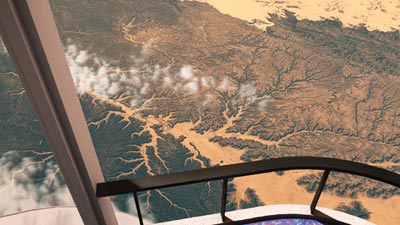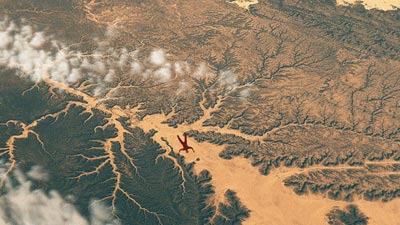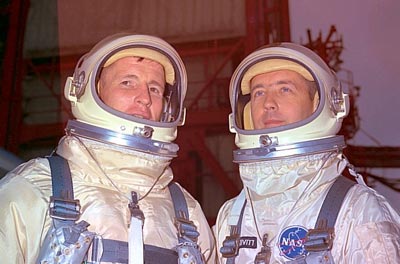
From Project Gemini to the final frontierby Dwayne A. Day
|
 The Hadramawt Plateau dry river basin in southern Saudi Arabia was photographed by the Gemini 4 astronauts and later featured in a Star Trek episode. (credit: CBS) |
“The Cloud Minders” was an episode from Star Trek’s third and last season, which even diehard fans admit was when the show’s overall quality had declined substantially. It was written by David Gerrold, who earned eternal fame by writing the classic episode “The Trouble With Tribbles.”
“The Cloud Minders” is obviously inspired by the classic Fritz Lang movie Metropolis. It features a world named Ardana where the oppressed workers toil in mines below the ground while privileged aristocrats live above them—way above them, in Stratos, a city floating in the clouds. (How this is accomplished, and why it would even be conceived in the first place, is never explained.) Gerrold later disowned the story when he did not like that it was rewritten to blame the miners’ anger and aggression not on their oppression, but a noxious gas. The episode is dull. Leonard Nimoy’s portrayal of Spock is flat and listless and out of character. The only thing memorable about the episode is a beautiful babe in a knockout dress. It is certainly not one of my favorites (for what it’s worth, my all time fave is the original, unaired pilot episode, “The Cage”).
 An unfortunate miner falling to his death—but at least the view is spectacular. (credit: CBS) |
I told Mike that I suspected that the image used in the 1969 episode was taken during a NASA Gemini mission. Gemini astronauts had devoted a considerable amount of time to Earth photography and of course Star Trek was filmed during that time period. My guess was that it was taken on Gemini 5, 6 or 7 and I was not sure how easy it would be to find the original photograph, but the fact that Star Trek had used the image in 1969 meant that it was probably widely distributed in press releases. So I headed over to NASA Headquarters one morning to look in their archives. I met up with archivist John Hargenreder there and showed him a copy of the still image from Star Trek and asked if they had any collections of Gemini press release images. By total coincidence, John recognized the image from a book with a collection of Gemini photographs. We pulled the book off the shelf, flipped through the pages, and within half a minute we found it, along with information identifying the area and the mission—Gemini 4 in 1965 (my guess had been close, but wrong). I then went to NASA’s fifth floor Still Images Archive and within a few minutes of looking, located and requested a color transparency of the image. Total amount of research time: about fifteen minutes (not counting travel and getting thru NASA security), but an important part of research is knowing where to go, where to look, and who to talk to. Luckily, I knew about John.
The photograph was taken by astronauts Ed White and Jim McDivitt in 1965 and shows the Hadramawt Plateau dry river basin in southern Saudi Arabia. Because the surrounding terrain is desert, the overall tinge of the photograph is yellow, not much different than the orangish sky in the Star Trek episode.
 Gemini 4 astronauts Ed White and Jim McDivitt, who took the image used in the Star Trek episode. (credit: NASA) |
I sent the photograph off to Mike Okuda and did not think about it again. Apparently the remastered episode’s airing in the United States was delayed for complicated series production reasons, but it finally aired in July 2008. Mike had sent me a still of the new cloud city matte painting showing the city floating high above the desert scene that I had provided, but I was still surprised at how much the terrain image was actually used in the episode, appearing at least half a dozen times, including a shot of an unfortunate miner falling to his death over the Hadramawt Plateau—er, Ardana. In the matte painting, the digital effects artists added in distant mountains on the horizon from a photograph taken from the International Space Station. So the picture includes not only an entirely fictional city, but two actual images taken from space forty years apart.
Alas, this little contribution to Star Trek does not seem to have enhanced my geek cred in either the science fiction or the NASA worlds, but it was still a bit of a kick to contribute in a tiny way to a show that was such a major part of my young life.